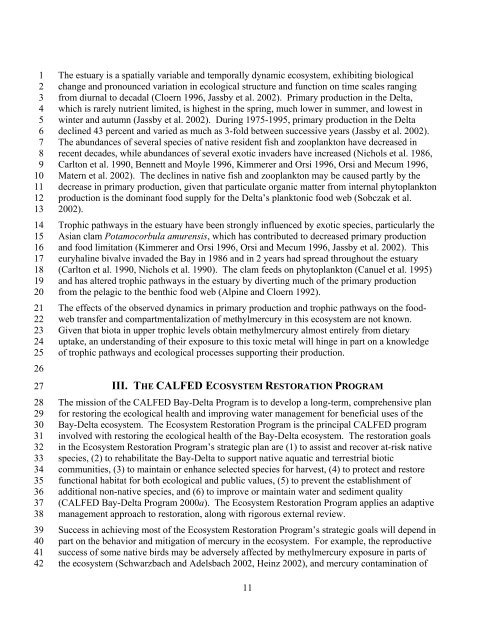Mercury Strategy for the Bay-Delta Ecosystem - CALFED Bay-Delta ...
Mercury Strategy for the Bay-Delta Ecosystem - CALFED Bay-Delta ...
Mercury Strategy for the Bay-Delta Ecosystem - CALFED Bay-Delta ...
You also want an ePaper? Increase the reach of your titles
YUMPU automatically turns print PDFs into web optimized ePapers that Google loves.
1<br />
2<br />
3<br />
4<br />
5<br />
6<br />
7<br />
8<br />
9<br />
10<br />
11<br />
12<br />
13<br />
14<br />
15<br />
16<br />
17<br />
18<br />
19<br />
20<br />
21<br />
22<br />
23<br />
24<br />
25<br />
26<br />
27<br />
28<br />
29<br />
30<br />
31<br />
32<br />
33<br />
34<br />
35<br />
36<br />
37<br />
38<br />
39<br />
40<br />
41<br />
42<br />
The estuary is a spatially variable and temporally dynamic ecosystem, exhibiting biological<br />
change and pronounced variation in ecological structure and function on time scales ranging<br />
from diurnal to decadal (Cloern 1996, Jassby et al. 2002). Primary production in <strong>the</strong> <strong>Delta</strong>,<br />
which is rarely nutrient limited, is highest in <strong>the</strong> spring, much lower in summer, and lowest in<br />
winter and autumn (Jassby et al. 2002). During 1975-1995, primary production in <strong>the</strong> <strong>Delta</strong><br />
declined 43 percent and varied as much as 3-fold between successive years (Jassby et al. 2002).<br />
The abundances of several species of native resident fish and zooplankton have decreased in<br />
recent decades, while abundances of several exotic invaders have increased (Nichols et al. 1986,<br />
Carlton et al. 1990, Bennett and Moyle 1996, Kimmerer and Orsi 1996, Orsi and Mecum 1996,<br />
Matern et al. 2002). The declines in native fish and zooplankton may be caused partly by <strong>the</strong><br />
decrease in primary production, given that particulate organic matter from internal phytoplankton<br />
production is <strong>the</strong> dominant food supply <strong>for</strong> <strong>the</strong> <strong>Delta</strong>’s planktonic food web (Sobczak et al.<br />
2002).<br />
Trophic pathways in <strong>the</strong> estuary have been strongly influenced by exotic species, particularly <strong>the</strong><br />
Asian clam Potamocorbula amurensis, which has contributed to decreased primary production<br />
and food limitation (Kimmerer and Orsi 1996, Orsi and Mecum 1996, Jassby et al. 2002). This<br />
euryhaline bivalve invaded <strong>the</strong> <strong>Bay</strong> in 1986 and in 2 years had spread throughout <strong>the</strong> estuary<br />
(Carlton et al. 1990, Nichols et al. 1990). The clam feeds on phytoplankton (Canuel et al. 1995)<br />
and has altered trophic pathways in <strong>the</strong> estuary by diverting much of <strong>the</strong> primary production<br />
from <strong>the</strong> pelagic to <strong>the</strong> benthic food web (Alpine and Cloern 1992).<br />
The effects of <strong>the</strong> observed dynamics in primary production and trophic pathways on <strong>the</strong> foodweb<br />
transfer and compartmentalization of methylmercury in this ecosystem are not known.<br />
Given that biota in upper trophic levels obtain methylmercury almost entirely from dietary<br />
uptake, an understanding of <strong>the</strong>ir exposure to this toxic metal will hinge in part on a knowledge<br />
of trophic pathways and ecological processes supporting <strong>the</strong>ir production.<br />
III. THE <strong>CALFED</strong> ECOSYSTEM RESTORATION PROGRAM<br />
The mission of <strong>the</strong> <strong>CALFED</strong> <strong>Bay</strong>-<strong>Delta</strong> Program is to develop a long-term, comprehensive plan<br />
<strong>for</strong> restoring <strong>the</strong> ecological health and improving water management <strong>for</strong> beneficial uses of <strong>the</strong><br />
<strong>Bay</strong>-<strong>Delta</strong> ecosystem. The <strong>Ecosystem</strong> Restoration Program is <strong>the</strong> principal <strong>CALFED</strong> program<br />
involved with restoring <strong>the</strong> ecological health of <strong>the</strong> <strong>Bay</strong>-<strong>Delta</strong> ecosystem. The restoration goals<br />
in <strong>the</strong> <strong>Ecosystem</strong> Restoration Program’s strategic plan are (1) to assist and recover at-risk native<br />
species, (2) to rehabilitate <strong>the</strong> <strong>Bay</strong>-<strong>Delta</strong> to support native aquatic and terrestrial biotic<br />
communities, (3) to maintain or enhance selected species <strong>for</strong> harvest, (4) to protect and restore<br />
functional habitat <strong>for</strong> both ecological and public values, (5) to prevent <strong>the</strong> establishment of<br />
additional non-native species, and (6) to improve or maintain water and sediment quality<br />
(<strong>CALFED</strong> <strong>Bay</strong>-<strong>Delta</strong> Program 2000a). The <strong>Ecosystem</strong> Restoration Program applies an adaptive<br />
management approach to restoration, along with rigorous external review.<br />
Success in achieving most of <strong>the</strong> <strong>Ecosystem</strong> Restoration Program’s strategic goals will depend in<br />
part on <strong>the</strong> behavior and mitigation of mercury in <strong>the</strong> ecosystem. For example, <strong>the</strong> reproductive<br />
success of some native birds may be adversely affected by methylmercury exposure in parts of<br />
<strong>the</strong> ecosystem (Schwarzbach and Adelsbach 2002, Heinz 2002), and mercury contamination of<br />
11

















